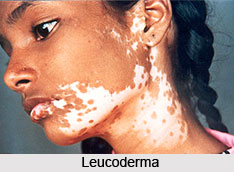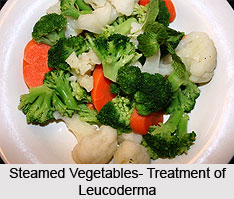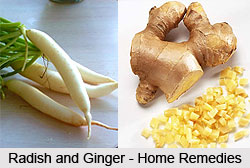 Leucoderma, also known as vitiligo, is a distressing skin condition that mostly affects hands, neck, back and the wrists of the patients. The word literally means `white skin`, since the gradual loss of pigment melanin from the skin layers, results in white patches. These patches look ugly, especially in persons with dark complexions. This condition does not cause any organic harm, but it brings about great psychological tension to the patient who is more embarrassed than the victim of any pain or discomfort. The condition thus, besides being a medical problem, also becomes a social stigma.
Leucoderma, also known as vitiligo, is a distressing skin condition that mostly affects hands, neck, back and the wrists of the patients. The word literally means `white skin`, since the gradual loss of pigment melanin from the skin layers, results in white patches. These patches look ugly, especially in persons with dark complexions. This condition does not cause any organic harm, but it brings about great psychological tension to the patient who is more embarrassed than the victim of any pain or discomfort. The condition thus, besides being a medical problem, also becomes a social stigma.
Leucoderma is a fairly common disorder and it affects one percent or more of the world`s population, especially in India. The disorder can occur at any age in either sex, but more in women than men on their normal skin. It should however, be noted that germs do not cause leucoderma nor is it due to bad blood and it is neither infectious nor contagious and hence, it cannot be transmitted from one person to another by physical contact.
Symptoms of Leucoderma:
The problem usually starts with a small white spot and later on it develops into patches. These patches are pale in the beginning but become whiter and whiter as time passes due to loss of pigment. As spots enlarge, they merge into each other and, in course of time, form a very broad patch. In some cases most of the skin of the body may be covered with white patches.
Causes of Leucoderma:
Many wrong beliefs are prevalent about the causes of leucoderma. Eating fish and drinking milk at the same time, as it is generally believed because even vegetarians suffer from this disorder does not cause it. Other food combination such as pumpkin and milk, onion and milk as possible causes of leucoderma also has no basis.
 The main causes of leucoderma are excessive mental worry, chronic or acute gastric disorder, impaired hepatic function such as jaundice, worms or other parasites in the alimentary canal, ailments like typhoid which affect the gastrointestinal tract, defective perspirative mechanism and bum injuries. Often the hormone secreting glands are involved in this disorder. Heredity is also a causative factor and about 30 per cent of patients have a family history of the disorder.
The main causes of leucoderma are excessive mental worry, chronic or acute gastric disorder, impaired hepatic function such as jaundice, worms or other parasites in the alimentary canal, ailments like typhoid which affect the gastrointestinal tract, defective perspirative mechanism and bum injuries. Often the hormone secreting glands are involved in this disorder. Heredity is also a causative factor and about 30 per cent of patients have a family history of the disorder.
Treatment of Leucoderma by Nature Cure:
In nature cure, the treatment of leucoderma consists of adoption of constitutional measures to cleanse the system of accumulated toxins. The diet hence, is a very important factor and the patient should undertake a fast on juices for about a week. In this regimen, the patient should take fruit or vegetable juices, diluted with water on 50:50 basis every two or three hours from 8.00 a.m. to 8.00 p.m. The bowels should be cleansed daily with warm water enema during this period.
After the juice fast, the patient may adopt a restricted diet consisting of fresh fruits, raw or steamed vegetables and whole meal bread or chapatis. Curd and milk may be added to this diet after a few days and the patient may thereafter gradually embark upon a well-balanced diet of seeds, nuts and grains, vegetables and fruits. The large proportion of the diet should consist of raw foods. Seeds and beans such as alfalfa, moong and soybeans can be sprouted. This diet may be supplemented with cold-pressed vegetable oils, honey and yeast. Juice fasting may be repeated at intervals of two months.
The patient should avoid tea, coffee, alcoholic beverages and all condiments and highly flavored dishes along with sugar, white flour products, denatured cereals like polished rice and pearled barley and tinned or bottled foods.
Home Remedies:
There are many home remedies also, that are useful for leucoderma. One is the use of red clay, which is found by the riverside or on hill slopes, which should be mixed in ginger juice and applied over the white spots once a day. The copper contained in the clay seems to bring back skin pigmentation and ginger juice serves as a milk stimulant, facilitating increased blood flow to the spots. Drinking water kept overnight in a copper vessel also helps in the reduction of leucoderma.

A paste made from the seeds of the radish is valuable in treating leucoderma. About 35 grams of these seeds should be powdered in vinegar and applied on the white patches. For better results, seeds should be finely pounded, mixed with a little white arsenic and soaked in vinegar at night. After two hours, when leaves appear, it should be rubbed on the leucoderma patches.
The use of turmeric and mustard oil is also considered beneficial in the treatment of leucoderma. About 500 Gms of turmeric should be pounded and soaked in eight kgs of water at night. It should be heated in the morning till only one kg. of water is left. It should then be strained and mixed with 500 Gms of mustard oil. This mixture should be heated till only the oil is left and it should be applied on white patches every morning and evening for a few months.




